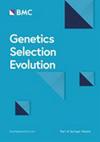Phenotype transition from wild mouflon to domestic sheep
IF 3.6
1区 农林科学
Q1 AGRICULTURE, DAIRY & ANIMAL SCIENCE
引用次数: 0
Abstract
The domestication of animals started around 12,000 years ago in the Near East region. This “endless process” is characterized by the gradual accumulation of changes that progressively marked the genetic, phenotypic and physiological differences between wild and domesticated species. The main distinctive phenotypic characteristics are not all directly attributable to the human-mediated selection of more productive traits. In the last decades, two main hypotheses have been proposed to clarify the emergence of such a set of phenotypic traits across a variety of domestic species. The first hypothesis relates the phenotype of the domesticated species to an altered thyroid hormone-based signaling, whereas the second one relates it to changes in the neural crest cells induced by selection of animals for tameness. These two hypotheses are not necessarily mutually exclusive since they may have contributed differently to the process over time and space. The adaptation model induced by domestication can be adopted to clarify some aspects (that are still controversial and debated) of the long-term evolutionary process leading from the wild Neolithic mouflon to the current domestic sheep. Indeed, sheep are among the earliest animals to have been domesticated by humans, around 12,000 years ago, and since then, they have represented a crucial resource in human history. The aim of this review is to shed light on the molecular mechanisms and the specific genomic variants that underlie the phenotypic variability between sheep and mouflon. In this regard, we carried out a critical review of the most recent studies on the molecular mechanisms that are most accredited to be responsible for coat color and phenotype, tail size and presence of horns. We also highlight that, in such a complicate context, sheep/mouflon hybrids represent a powerful and innovative model for studying the mechanism by which the phenotypic traits related to the phenotypic responses to domestication are inherited. Knowledge of these mechanisms could have a significant impact on the selection of more productive breeds. In fact, as in a journey back in time of animal domestication, the genetic traits of today’s domestic species are being progressively and deliberately shaped according to human needs, in a direction opposite to that followed during domestication.从野生绵羊到家养绵羊的表型转变
动物驯化大约始于 1.2 万年前的近东地区。这一 "无休止的过程 "的特点是逐渐积累的变化,这些变化逐渐标志着野生物种和驯化物种之间在遗传、表型和生理方面的差异。与众不同的主要表型特征并不都直接归因于人类对更多生产性特征的选择。在过去几十年中,人们提出了两个主要假说,以澄清在各种家养物种中出现这一系列表型特征的原因。第一种假说认为,驯化物种的表型与甲状腺激素信号的改变有关,而第二种假说则认为,驯化动物的选择诱发了神经嵴细胞的变化。这两种假说并不一定相互排斥,因为它们可能在时间和空间上对这一过程做出了不同的贡献。驯化引起的适应模式可用于澄清从新石器时代的野生绵羊到现在的家羊这一长期进化过程的某些方面(这些方面仍存在争议和争论)。事实上,绵羊是人类最早驯化的动物之一,距今约 12000 年,从那时起,绵羊就成为人类历史上的重要资源。本综述旨在阐明绵羊和骡子之间表型变异的分子机制和特定基因组变异。在这方面,我们对最近的研究进行了批判性的回顾,这些研究涉及的分子机制最有可能导致被毛颜色和表型、尾巴大小和角的存在。我们还强调,在如此复杂的背景下,绵羊/牛羚杂交种是研究与驯化表型反应相关的表型特征遗传机制的一个强大而创新的模型。对这些机制的了解可能会对选择更高产的品种产生重大影响。事实上,正如动物驯化的时间回溯一样,当今家养物种的遗传特征正在根据人类的需要被逐步和有意地塑造,其方向与驯化过程中的方向相反。
本文章由计算机程序翻译,如有差异,请以英文原文为准。
求助全文
约1分钟内获得全文
求助全文
来源期刊

Genetics Selection Evolution
生物-奶制品与动物科学
CiteScore
6.50
自引率
9.80%
发文量
74
审稿时长
1 months
期刊介绍:
Genetics Selection Evolution invites basic, applied and methodological content that will aid the current understanding and the utilization of genetic variability in domestic animal species. Although the focus is on domestic animal species, research on other species is invited if it contributes to the understanding of the use of genetic variability in domestic animals. Genetics Selection Evolution publishes results from all levels of study, from the gene to the quantitative trait, from the individual to the population, the breed or the species. Contributions concerning both the biological approach, from molecular genetics to quantitative genetics, as well as the mathematical approach, from population genetics to statistics, are welcome. Specific areas of interest include but are not limited to: gene and QTL identification, mapping and characterization, analysis of new phenotypes, high-throughput SNP data analysis, functional genomics, cytogenetics, genetic diversity of populations and breeds, genetic evaluation, applied and experimental selection, genomic selection, selection efficiency, and statistical methodology for the genetic analysis of phenotypes with quantitative and mixed inheritance.
 求助内容:
求助内容: 应助结果提醒方式:
应助结果提醒方式:


